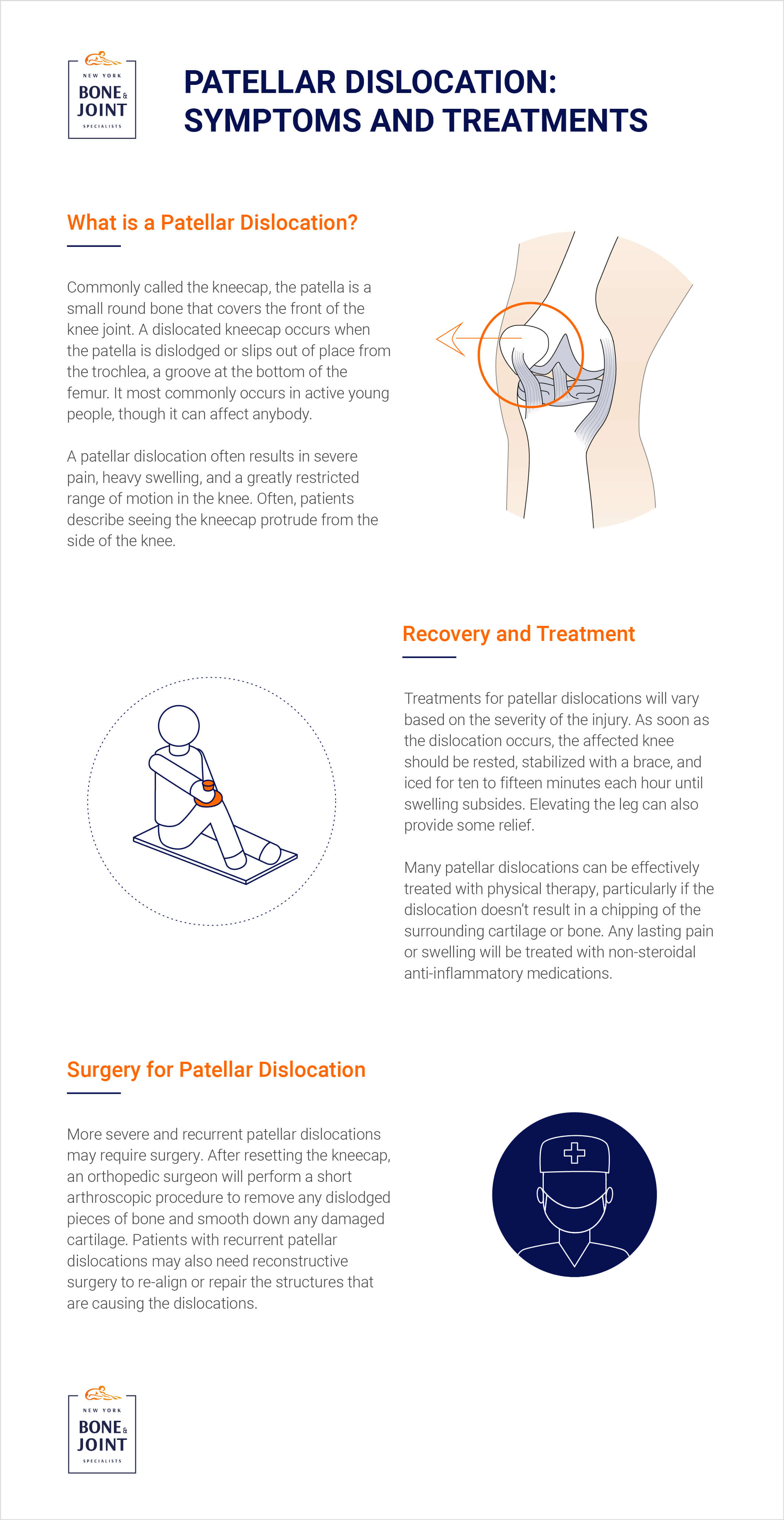A dislocated kneecap (called the patella) occurs when the patella is dislodged or slips out of place from the trochlea, a groove at the bottom of the femur. It most commonly occurs in active people younger than thirty, though it can affect anybody.
KNEECAP DISLOCATION
Commonly called the kneecap, the patella is the small round bone that covers the front of the knee joint, effectively serving as a fulcrum. A dislocation of the patella results in severe pain, heavy swelling, and a greatly restricted range of motion in the affected knee. Often, people will describe seeing the knee cap protruding from the side of the knee. Some patients recover from a dislocation and never experience the condition again. For other patients, however, the patella will chronically dislocate until it is repaired through surgery.
DISLOCATED KNEECAP RECOVERY & TREATMENT
Treatments for patellar dislocations will vary based on the chronicity and severity of the injury. As soon as the dislocation occurs for the first time, the affected knee should be rested, stabilized with a brace, and iced for ten to fifteen minutes each hour until swelling subsides. Elevating the leg can also provide some relief. Additional treatment will likely entail an intensive physical therapy program, though surgery may be necessary in more severe cases.
KNEE BRACES AND RECOVERY EXERCISES FOR A DISLOCATED KNEECAP
Many patellar dislocations can be effectively treated with physical therapy, particularly if the dislocation doesn’t result in a chipping of the surrounding cartilage or bone. Any lasting pain or swelling will be treated with non-steroidal anti-inflammatory medications. A typical rehabilitation program entails five to six weeks of strengthening exercises designed to rebuild the muscles surrounding the patella and restore the range of motion. Most patients also wear a brace throughout recovery to ensure the knee’s stability and prevent further dislocations.

KNEECAP DISLOCATION SURGERY OPTIONS
More severe and recurrent patellar dislocations may require surgery. After resetting the kneecap, an orthopedic surgeon will perform a short arthroscopic procedure to remove any dislodged pieces of bone and smooth down any damaged cartilage. Patients with recurrent patella dislocations may also need reconstructive surgery to re-align or repair the structures that are causing the dislocations.
One of the most common surgical options entails the reconstruction of the medial patellofemoral ligament with a graft. The graft is harvested from the hamstring tendons or a cadaver donor and reattached to the femur bone and patella. This procedure can be performed arthroscopically, preventing damage to surrounding tissues and resulting in fewer complications. In the most serious cases, a surgeon may need to alter the structure of the surrounding bones or ligaments to stabilize the patella and prevent future dislocations.
HOW LONG DOES A DISLOCATED PATELLA TAKE TO HEAL?
As with any sports injury, the timeline for recovery from a patellar dislocation can vary widely. Most patients should recover completely in six to eight weeks, but more severe cases may require as many as three to four months to heal properly.
IF YOU’RE SUFFERING FROM KNEE PAIN:
If you’re experiencing heavy pain or swelling or have suffered a traumatic injury to the knee, you should contact an orthopedic specialist as soon as possible to discuss your symptoms and possible courses of treatment. At New York Bone and Joint, we’ve specialized in patellar dislocations and other knee injuries for almost twenty years, delivering attentive and empathetic care that ensures long-term recovery for our patients.
After a quick physical examination and a series of X-rays, MRIs, and CT scans, your specialist will identify the cause and extent of your condition and develop a treatment plan tailored to your specific needs. Call and schedule an appointment with our specialists today.
_________________________________
EXPERIENCING PAIN? DO YOU HAVE AN INJURY?
Our Specialists are here to help.
Book an appointment with NYC’s best orthopedic specialists to discuss your condition. Fill out the form below and you will receive a call from our office within 5-10 minutes. We’ll book an appointment at a time and location that work for you, and send you a reminder by email.
FAQs: Patellar Dislocation
What causes a patellar (kneecap) dislocation, and who is most at risk?
A kneecap dislocation often happens from a sudden twist, sharp turn, direct blow, or impact while the foot is planted. Certain anatomical or biomechanical factors increase risk, such as a shallow trochlear groove, high patella (patella alta), ligamentous laxity, muscle imbalance around the knee/hip, valgus knee alignment, or prior dislocation.
How is a patellar dislocation diagnosed?
Diagnosis involves a medical history, physical examination (checking for swelling, deformity, tenderness, ability to move the knee), and imaging. Initial imaging is usually X-rays to assess for fractures. An MRI may follow to reveal soft tissue injury (ligament tears, damage to cartilage) and loose fragments inside the joint.
What is the difference between non-surgical vs. surgical treatment for patellar dislocation?
Many first-time dislocations are treated non-surgically: rest, ice, bracing/splinting, possibly crutches, and physical therapy to restore strength, stability, and range of motion. Surgery is considered if there are loose fragments, cartilage or bone damage, recurrent dislocations, or significant instability that doesn’t improve with conservative care.
How long does recovery take after a patellar dislocation?
Recovery depends on how severe the injury was, whether surgery was needed, and how well rehabilitation is followed. Many people treated non-surgically begin walking with less pain within a few weeks, and daily activities often resume in about 6-8 weeks. Return to sports or high intensity activity may take 3-4 months or more, especially if surgery was involved.












